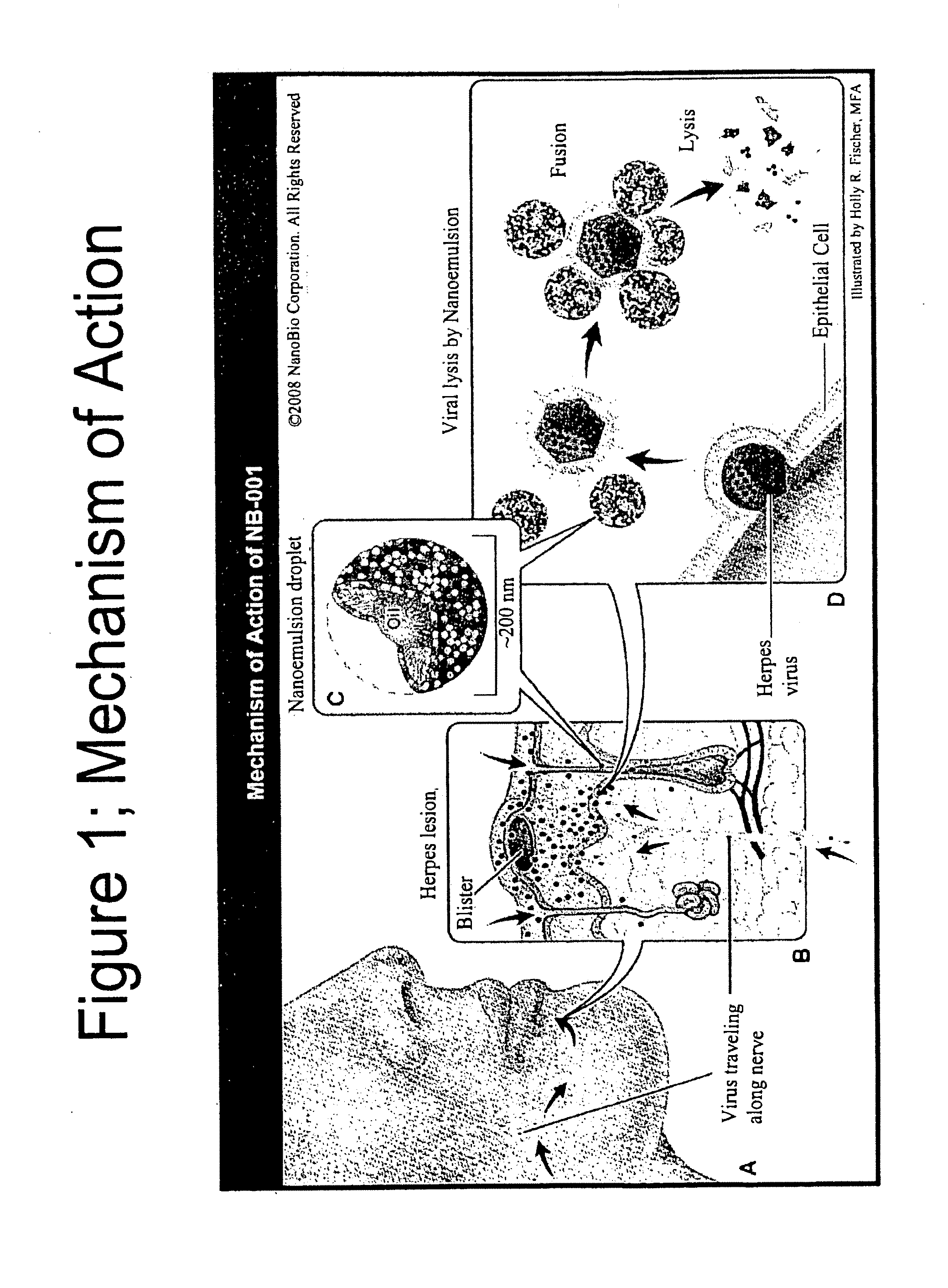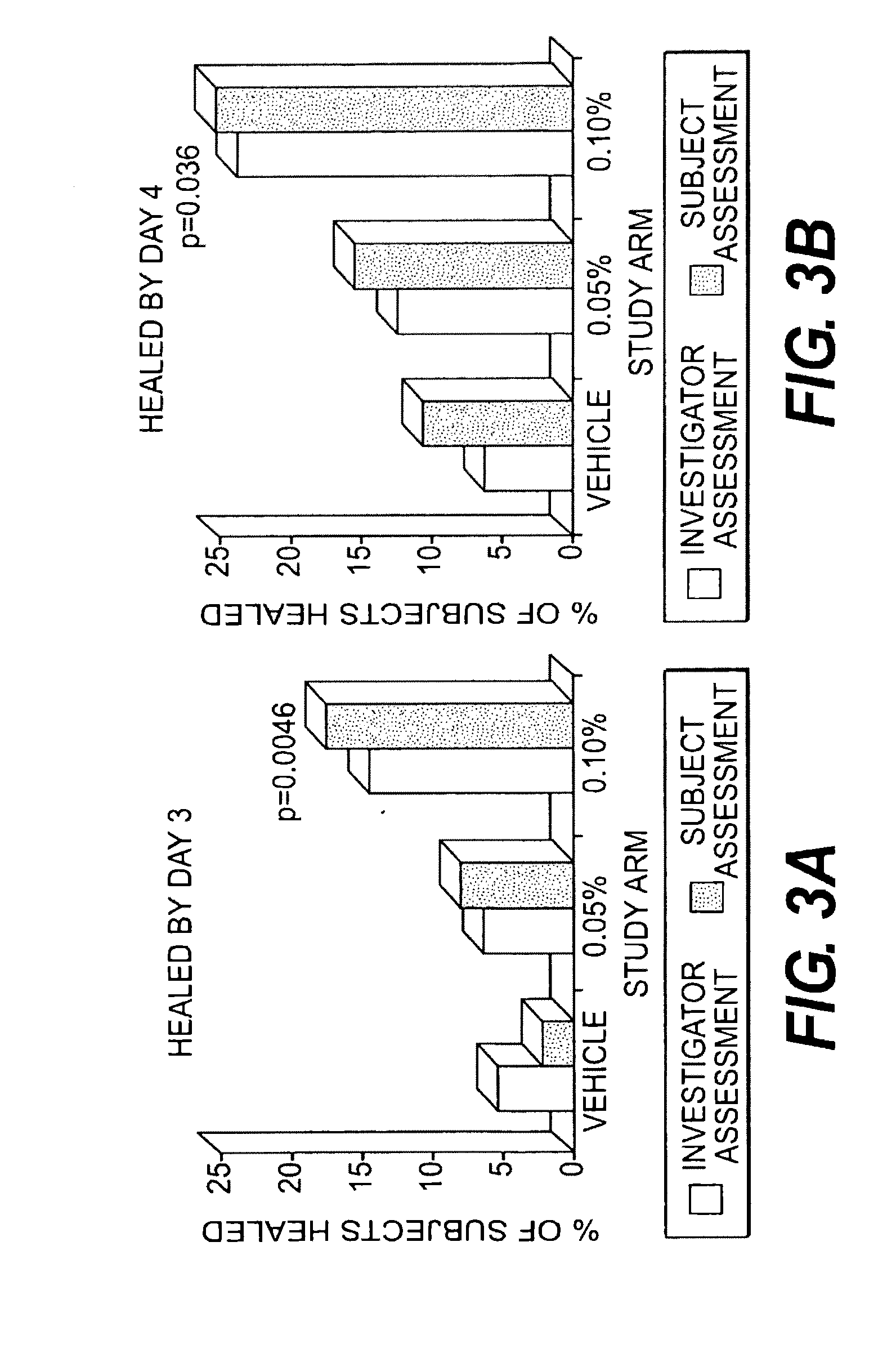Methods for treating herpes virus infections
a technology for herpes virus and infection, applied in the field of herpes virus infection treatment methods, can solve the problems of cold sores, high viral titers, and high contagiousness, and achieve the effects of preventing reactivation of herpes virus, and minimizing reactivation
- Summary
- Abstract
- Description
- Claims
- Application Information
AI Technical Summary
Benefits of technology
Problems solved by technology
Method used
Image
Examples
example 1
Phase 2A Study Regarding the Use of a Nanoemulsion to Treat Herpes Labialis
[0213]Three different nanoemulsions were prepared, all comprising soybean oil, Tween 20, ethanol, CPC, EDTA, and water. The formulations are summarized in Tables 5 and 6 below.
TABLE 5TweenEDTAForm.Soybean20EthanolCPC %%H2O(CPC %)oil (%)(%)(%)(mg / mL)(mM)(%)Formulation1.570.150.170.0270.001998.09#1; 0.025%(0.025)(0.05)Formulation3.140.300.340.0530.003796.17#2; 0.05%(0.5) (0.1)Formulation6.280.590.670.1070.007592.34#3; 0.1%(1) (0.2)
TABLE 6Nanoemulsion Formulations Used in Clinical TrialsEmulsionCPCDilutionConcentrationConcentrationMurine Herpes Model1:502%0.02%Doses in Herpes Labialis Phase 2A0.025% NB-0011:402.5% 0.025%0.05% NB-0011:20 5%0.05%0.10% NB-0011:1010%0.10%Doses in Herpes Labialis Phase 2B0.10% NB-0011:1010%0.10%*0.30 NB-001 1:3.330%0.30%0.50% NB-0011:2 50%0.50%***Maximum CPC concentration monographed for OTC use in humans.**Maximum CPC concentration tested in 9 month minipig study.
[0214]The study d...
example 2
The Nanoemulsions are Safe for Topical Application in Animals and Humans
[0234]In vivo safety studies were performed to confirm safety of the nanoemulsions for human use. The composition of the tested nanoemulsions is shown in Table 13.
TABLE 13Nano-emulsion(CPCSoy-concen-beanTweenEthanolCPC %EDTA%tration)oil %20 %%(mg / mL)% (mM)H2O10 mg / mL 62.795.926.731.0680.0745 (2)23.425 mg / mL31.402.963.370.530.0373 (1)61.703 mg / mL18.841.782.020.3200.0224 (0.6)77.031 mg / mL6.280.590.670.1070.0075 (0.2)92.340 mg / mL12.561.181.3500.0149 (0.4)84.90
[0235]10 female and 10 male guinea pigs were treated to determine if the nanoemulsions led to dermal—sensitization by administration of 10 mg / ml of the nanoemulsion three times weekly for three consecutive weeks, and then challenged for 6 hrs one week later. Dermal toxicity studies were also performed in groups of 4 female and 4 male minipigs that were subject to administration of 0.1-1 mg / cm2 of the nanoemulsion daily for 9 months. Table 14 summarizes the res...
example 3
The Nanoemulsions Are Stable
[0241]The purpose of this example was to investigate the long term physiochemical stability of a nanoemulsion according to the invention.
[0242]Using validated analytical methods, three strengths (0.1% w / v, 0.25% w / v, and 0.5% w / v) of a nanoemulsion formulation (NB-001) was tested over a period of up to 36 months, at appropriate International Conference on Harmonization (ICH) storage conditions, to determine changes in potency, physical appearance, particle size distribution, and pH. Emulsion physical stability was assessed by monitoring changes in physical appearance (i.e., settling, creaming, color change, and phase separation). The nanoemulsions were assessed by general appearance (white homogenous liquid with no signs of separation), pH (4-6) by a pH meter, droplet size (<400 nm) by laser light diffraction light scattering using a Beckman Coulter N4 Particle Size Analyzer, and potency. The cationic surfactant present in the nanoemulsion, cetylpyridiniu...
PUM
| Property | Measurement | Unit |
|---|---|---|
| diameter | aaaaa | aaaaa |
| diameter | aaaaa | aaaaa |
| diameter | aaaaa | aaaaa |
Abstract
Description
Claims
Application Information
 Login to View More
Login to View More - R&D
- Intellectual Property
- Life Sciences
- Materials
- Tech Scout
- Unparalleled Data Quality
- Higher Quality Content
- 60% Fewer Hallucinations
Browse by: Latest US Patents, China's latest patents, Technical Efficacy Thesaurus, Application Domain, Technology Topic, Popular Technical Reports.
© 2025 PatSnap. All rights reserved.Legal|Privacy policy|Modern Slavery Act Transparency Statement|Sitemap|About US| Contact US: help@patsnap.com



